In the vast tapestry of the natural world, certain birds stand out with their remarkable feature – long necks. These avian wonders have captured our attention with their elegant and elongated necks that seem to defy gravity. From the majestic swans gliding gracefully on calm waters to the striking herons patiently stalking their prey, these birds exhibit a unique adaptation that sets them apart. Join us as we embark on a fascinating exploration of birds with long necks, delving into their anatomy, behaviors, and the evolutionary advantages that come with their elongated stature. Get ready to be inspired by their grace and marvel at the wonders of nature as we unravel the secrets behind their remarkable necks.
List of Birds with Long Necks
Great Egret

- Scientific name: Ardea alba
- Lifespan: 15 years
- Size: 3 feet
- Native to: Asia, Africa, the Americas, and southern Europe
Great Egret is a magnificent bird known for its long, slender neck. It is a large heron species found in various parts of the world, including North and South America, Europe, Africa, and Asia. The Great Egret has white plumage, a yellow bill, and long black legs. It stands tall and erect, with its long neck elegantly extended. These birds inhabit wetland areas such as marshes, swamps, and shores, where they feed on fish, amphibians, and other small aquatic creatures. They are skilled hunters, using their sharp beaks to spear their prey. During the breeding season, Great Egrets develop long, delicate plumes on their back, adding to their striking appearance. They are often seen wading through shallow water, patiently searching for food.
Blue Heron

- Scientific name: Ardea alba
- Lifespan: 15 years
- Size: 3 feet
- Native to: Asia, Africa, the Americas, and southern Europe
Great Blue Heron is a large wading bird with a distinctive long neck. It is commonly found in North and Central America, as well as parts of the Caribbean. With its blue-gray plumage, long legs, and long, S-shaped neck, the Great Blue Heron is an iconic sight in wetland habitats. These birds prefer to dwell near bodies of water such as marshes, swamps, and rivers, where they can catch fish and other aquatic prey. Their diet also includes amphibians, reptiles, small mammals, and even insects. The Great Blue Heron uses its long neck and sharp bill to strike at prey with precision. When hunting, it often stands still or moves slowly, blending in with its surroundings until the perfect moment to strike. Despite their large size, Great Blue Herons are skilled fliers and can be seen soaring gracefully through the air.
Snowy Egret (White Birds with Long necks)

- Scientific name: Egretta thula
- Lifespan: 16 years
- Size: 20-27 inches
- Native to: United States and southern Canada, south through Central America, the West Indies, South America, and Argentina
Snowy Egret is a beautiful wading bird known for its long, slender neck adorned with a crest of wispy plumes. It is found in the Americas, from the United States down to parts of South America. The Snowy Egret has mostly white plumage, a black bill, and contrasting black legs and feet. During the breeding season, its stunning plumage becomes even more pronounced, with delicate plumes extending beyond its body. These birds inhabit various wetland habitats, including marshes, swamps, and coastal areas, where they feed on fish, amphibians, crustaceans, and insects. Snowy Egrets are agile hunters, using their long necks to quickly strike at their prey. They are known for their graceful movements, often seen wading through shallow water or perched on branches near the water’s edge.
Tricolored heron

- Scientific name: Egretta tricolor
- Lifespan: 17 years
- Size: 24-26 inches
- Native to: Northeastern United States, south along the coast, through the Gulf of Mexico and the Caribbean, to northern South America as far south as Brazil
Tricolored Heron is a medium-sized wading bird with a long neck that can be found in the Americas. It is named after its striking plumage, which consists of blue-gray feathers on its body, a white belly, and a rust-colored neck and head. These birds primarily inhabit coastal areas, marshes, and wetlands, where they forage for fish, crustaceans, and insects. With their long necks, Tricolored Herons gracefully stalk their prey in shallow waters, using their sharp beaks to snatch their meals. During the breeding season, their necks become adorned with long, filamentous plumes, adding to their allure. Tricolored Herons are known for their elegant movements and can often be seen wading through water or perched on branches near their hunting grounds.
Whooping Crane (Huge Birds with Long necks)

- Scientific name: Grus americana
- Lifespan: 22 to 30 years
- Size: 5 feet tall
- Native to: Canada and America
Whooping Crane is a critically endangered bird and one of the tallest birds in North America. It has a long, slender neck that is essential for its foraging and feeding behaviors. Whooping Cranes have striking white plumage, with black wingtips and a distinctive red crown on their heads. They are known for their loud, trumpeting calls that can carry over long distances. These majestic birds breed in northern Canada and migrate to coastal marshes and wetlands in the southern United States during the winter. Whooping Cranes primarily feed on aquatic invertebrates, small fish, and frogs, which they capture by probing in shallow water with their long beaks. Efforts are underway to protect and conserve this species, as they face numerous threats to their survival.
White-faced ibis
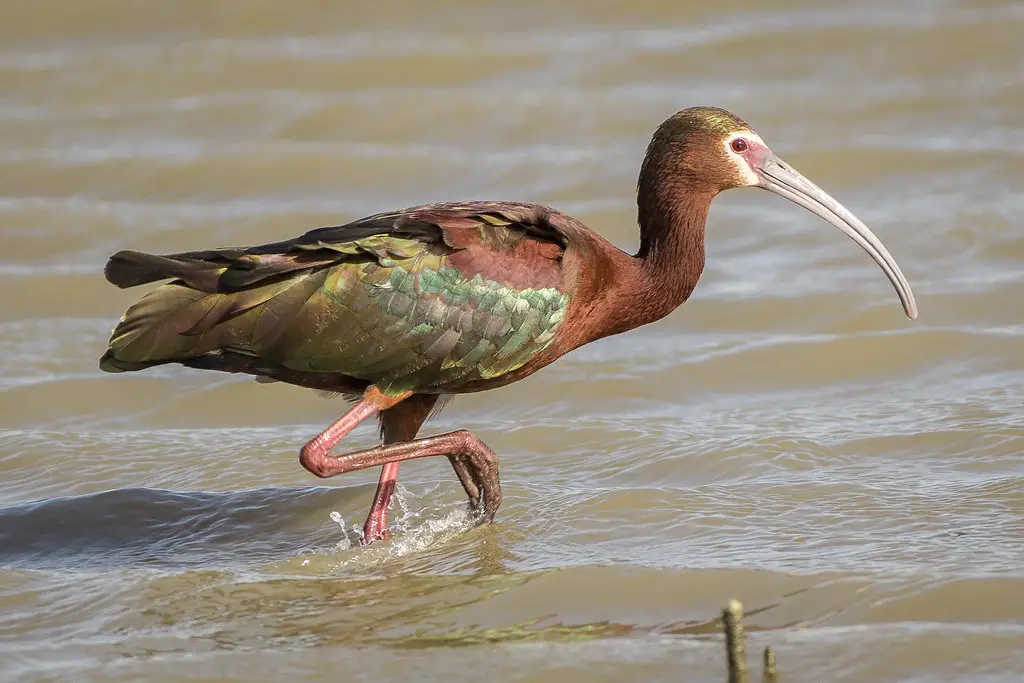
- Scientific name: Plegadis chihi
- Lifespan: 14 years
- Size: 18.1 to 22.0 inches
- Native to: Canada, the United States, Central America and the southern half of South America
White-faced Ibis is a medium-sized wading bird that is predominantly found in the Americas. It has a long, curved bill and a slender, flexible neck. These birds display a unique combination of iridescent colors, with dark brown feathers, metallic purples, and greens, and a distinct white face. White-faced Ibises inhabit wetlands, marshes, and flooded fields, where they probe their long bills into mud or shallow water to search for insects, crustaceans, and small aquatic creatures. They often forage in groups, moving their bills back and forth in a sweeping motion to capture prey. During the breeding season, their plumage intensifies, with males displaying vibrant colors to attract mates. White-faced Ibises are skilled fliers and can be seen soaring in formation or gracefully landing near their foraging sites.
Limpkin

- Scientific name: Aramus guarauna
- Lifespan: n/a
- Size: 28 inches
- Native to: United States
Limpkin is a unique bird with a long neck that is native to wetlands in the Americas. Despite its name, the Limpkin is not actually a true crane but is rather classified as a wading bird. It has a distinctive appearance, with a long, slender neck, a medium-sized body, and a slightly curved bill. The Limpkin’s plumage is primarily brown with white streaks and speckles, providing excellent camouflage in its marshy habitat. These birds are known for their loud and haunting calls, which resemble a screaming cry or a repetitive wail. Limpkins use their long necks and bills to probe the water and vegetation in search of their favorite prey: freshwater snails and mussels. Their unique feeding habits make them a crucial part of wetland ecosystems, helping to control the population of these mollusks.
American Flamingo

- Scientific name: Phoeniconaias minor
- Length: 90 cm
- Wingspan: 1 m
- Weight: 2-3 Kg
- Beak length on average is 5-7 inches (12.7-17.8 cm).
American Flamingo is a large bird with an unmistakable long neck and vibrant pink plumage. They are found in the Caribbean, the Galapagos Islands, and parts of South America. These social birds are known for their iconic feeding behavior, where they dip their long necks into the water and filter-feed on small aquatic organisms, such as algae, crustaceans, and insects. The Flamingo’s long neck and uniquely shaped bill enable them to reach deep into the water and mud to extract their food. Their striking pink coloration comes from the pigments found in the organisms they consume. American Flamingos often gather in large flocks and perform synchronized displays, making them a spectacle to behold.
Scarlet ibis (Red Birds with Long necks)

- Scientific name: Eudocimus ruber
- Lifespan: 16 years
- Size: 22 to 30 inches
- Native to: Northern South America southward along the coast of Brazil
Scarlet Ibis is a stunning bird with a long, curved neck and vibrant reddish-orange plumage. It is primarily found in the coastal regions of northern South America and some Caribbean islands. The Scarlet Ibis is known for its striking appearance, with its bright plumage standing out against the greenery of its mangrove and swamp habitats. These birds use their long necks to probe shallow water and mud in search of small aquatic invertebrates, including crustaceans and insects. Their curved bills are well-adapted for grasping and extracting prey. The color of their feathers intensifies with age, starting as dull gray juveniles and gradually transitioning to the vibrant scarlet hue as they mature. The Scarlet Ibis is not only a visual marvel but also holds cultural and symbolic significance in various cultures, representing beauty, transformation, and spirituality.
Grey heron

- Scientific name: Ardea cinerea
- Lifespan: 5 years
- Size: 40 inches
- Native to: Europe and Asia
The Gray Heron, also known as the Grey Heron, is a large wading bird with a long neck found in Europe, Asia, and parts of Africa. As its name suggests, it has predominantly gray plumage, a long and slender neck, and a sharp, pointed bill. Gray Herons are skilled hunters and often stand motionless in shallow water, patiently waiting for their prey to approach. With their long necks, they can strike quickly and accurately to catch fish, frogs, small mammals, and even birds. Their stealthy nature and striking appearance make them a captivating sight in wetlands and other freshwater habitats.
Purple Heron
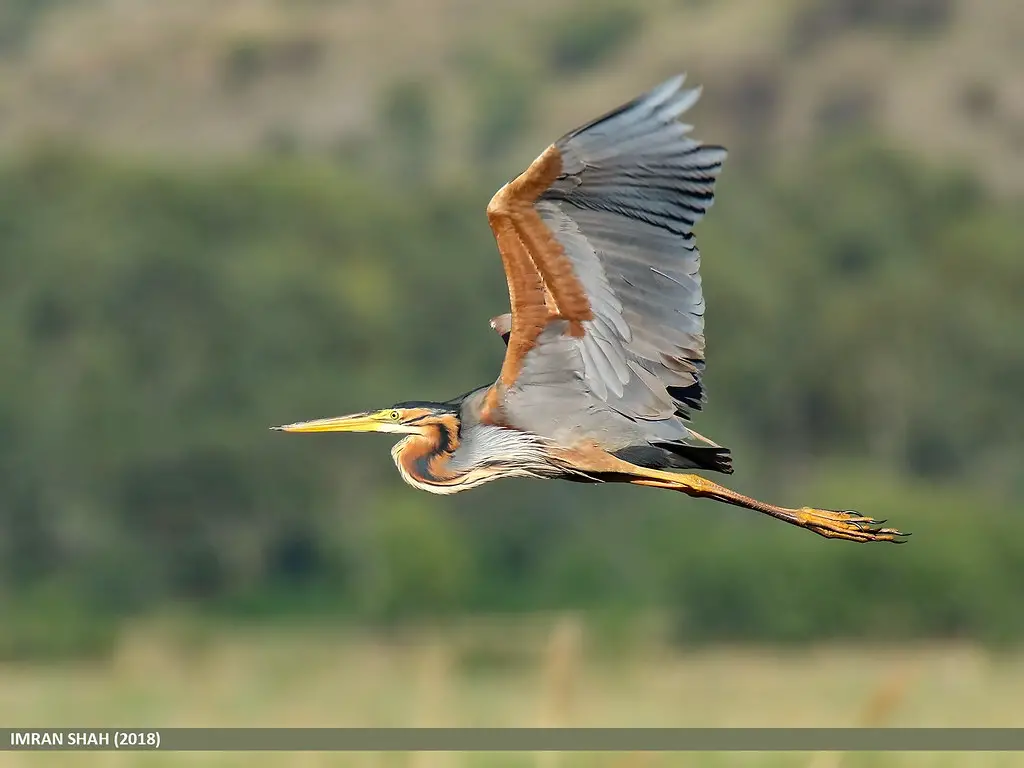
- Scientific name: Ardea purpurea
- Lifespan: 20 years
- Size: 31–38 in
- Native to: Central and southern Europe and parts of North Africa as far as Lake Balkhash in Kazakhstan
Purple Heron is a majestic bird with a distinctive long neck and beautiful plumage. It is native to Europe, Asia, and Africa, and its name comes from the purple-brown coloration found on its neck, head, and upper wings. This heron species has a slender and curved neck that aids in its hunting strategy. It patiently stalks its prey, which mainly consists of fish, amphibians, small mammals, and insects, in shallow waters. With a sudden strike, the Purple Heron captures its prey using its sharp bill. During breeding season, these birds develop long plumes on their necks and backs, adding to their allure. They are often found in wetlands, marshes, and other aquatic habitats.
Reddish egret

- Scientific name: Egretta rufescens
- Length: 80 cm
- Wingspan: 125 cm
- Weight: 600 gm
- Beaks typically measure 7.3–9.2 cm long
Reddish Egret is a striking bird with a long neck and a distinct reddish-brown plumage. It can be found in coastal areas of North America, Mexico, and the Caribbean. Reddish Egrets are known for their unique feeding behavior, characterized by an energetic and erratic dance-like motion. They use their long necks to dash through shallow water, often spreading their wings and creating a canopy-like effect to shade potential prey. This behavior, known as “canopy feeding,” helps to attract fish and other aquatic organisms. Once the prey is within reach, the egret uses its long neck and sharp bill to snatch it from the water. The Reddish Egret’s vibrant coloration and active feeding style make it a captivating bird to observe in its coastal habitats.
Sandhill crane (Birds with Long Necks)

- Scientific name: Grus canadensis
- Length: 90 cm
- Wingspan: 100 cm
- Weight: 3-4 Kg
- Beaks typically measure 4 inches
Sandhill Crane is a large bird with a long neck found in North America. It is known for its distinctive red crown, gray plumage, and long, slender legs. Sandhill Cranes are known for their elaborate mating dances, which involve jumping, bowing, and wing-flapping displays. They have a unique vocalization, a loud, trumpeting call that can be heard from a great distance. These birds are often seen in wetlands, grasslands, and agricultural fields, where they forage for insects, small mammals, amphibians, and plants. Sandhill Cranes are known for their migratory behavior, with populations traveling long distances between breeding and wintering grounds.
Little Blue Heron

- Scientific name: Ardea alba
- Lifespan: 15 years
- Size: 3 feet
- Native to: Asia, Africa, the Americas, and southern Europe
Little Blue Heron is a small heron species found in the Americas. Despite its name, its plumage is typically a slate blue or gray color as an adult, while juveniles are mostly white. This heron has a slender neck and a dagger-like bill, which it uses to catch fish, crustaceans, and other small aquatic prey. It can be found in marshes, swamps, and shallow coastal areas, where it stalks its prey stealthily and wades through the water with a slow and deliberate movement. The Little Blue Heron is a graceful bird and is often observed standing motionless or moving with elegance along the water’s edge.
Jabiru (Large Birds with Long Legs)

- Scientific name: Jabiru mycteria
- Lifespan: 30 years
- Size: 5 feet
- Native to: Mexico to Argentina, except west of the Andes.
- Beak length on average is 5-7 inches (12.7-17.8 cm).
Jabiru is a large stork species known for its distinctive appearance and long neck. It is found in parts of Central and South America. With its black and white plumage, a large black beak, and a distinctive red throat pouch, the Jabiru is an impressive bird. It has a long neck that allows it to reach deep into the water or vegetation to catch fish, frogs, reptiles, and even small mammals. Jabirus are often seen in wetlands, swamps, and floodplains, where they build large stick nests on tall trees. These majestic birds are known for their graceful flight and their role as apex predators in their ecosystems.
Cattle egret

- Scientific name: Bubulcus ibis
- Lifespan: 20 years
- Size: 19-21 inches
- Native to: Africa to humid Asian tropics, from India to Japan and northern Australia
Cattle Egret is a medium-sized egret species that is commonly found in open grasslands and agricultural areas. It has a long neck, a relatively short and thick bill, and a compact body. During the breeding season, the Cattle Egret develops beautiful plumage, including orange-buff feathers on its head, neck, and back. These birds are often seen foraging alongside livestock, where they feed on insects stirred up by the animals. Cattle Egrets are highly adaptable and can be found on every continent except Antarctica.
Spoonbill Roseate (Birds with Long Necks)
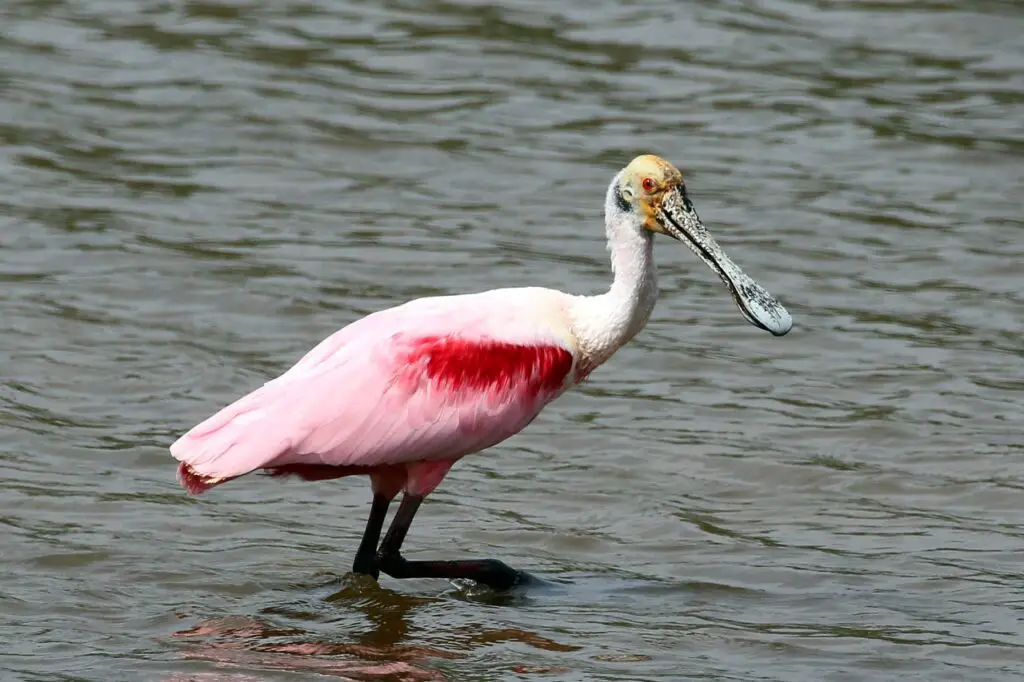
- Scientific name: Platalea ajaja
- Lifespan: 10 years
- Size: 24 inches
- Native to: southern Florida, coastal Texas, and southwestern Louisiana
- Beaks typically measure 4-6 inches (10-15 cm) in length.
RRoseate Spoonbill is a striking wading bird with a unique appearance. It has a long neck, a white body, and a spoon-shaped bill that is bright pink in color. This spoon-shaped bill is used to sweep through shallow water, catching small fish, crustaceans, and insects. The Roseate Spoonbill gets its pink coloration from the pigments present in the prey it consumes. These birds are known for their graceful flight and can be found in wetlands, marshes, and coastal areas of the Americas. The Roseate Spoonbill is a social bird and is often seen nesting and foraging in colonies.
American bittern

- Scientific name: Botaurus lentiginosus
- Lifespan: 8 years
- Size: 60 cm
- Native to: United States and Canada
American Bittern is a medium-sized heron species native to North America. It is known for its cryptic plumage that provides excellent camouflage among marsh vegetation. With its long neck and dagger-like bill, the American Bittern hunts for small fish, frogs, insects, and other aquatic prey in marshy habitats. What makes this bird unique is its ability to blend into its surroundings by standing still and assuming a tall, vertical posture, resembling the reeds and grasses around it. During courtship, male American Bitterns produce a distinctive booming call that can carry over long distances.
Purple Gallinule

- Scientific name: Porphyrio martinicus
- Lifespan: 7 years
- Size: 10–15 in
- Native to: Southern Florida, the Gulf and Pacific coast of Mexico, parts of Central America, and the Caribbean
Purple Gallinule is a vibrant and colorful bird found in the wetlands and marshes of the Americas. It has a striking plumage that includes shades of blue, green, purple, and red. The Purple Gallinule has long legs and toes that are adapted for walking on floating vegetation. It uses its strong bill to feed on a variety of plant materials, insects, and small aquatic creatures. These birds are known for their ability to walk on lily pads and other floating vegetation, giving them access to food sources that other birds may not reach. They are also excellent swimmers and can dive underwater when threatened. The Purple Gallinule is a vocal bird and has a repertoire of loud and distinctive calls.
Green heron

- Scientific name: Butorides virescens
- Lifespan: 10 years
- Size: 18 inches
- Native to: Northern South America, Mexico, and the United States
Green Heron is a small heron species found in wetland habitats throughout much of North and Central America. It gets its name from the greenish hue on its back and wings. Despite its small size, the Green Heron is an adept hunter and uses its sharp bill to catch fish, frogs, insects, and small aquatic animals. It is known for its patience and stealth, often remaining motionless for long periods before striking its prey. The Green Heron has a distinctive hunched posture and may extend its neck and raise its crest during territorial displays. It is a solitary bird and usually nests in trees near water bodies.
Brolga (Birds with Long Necks)
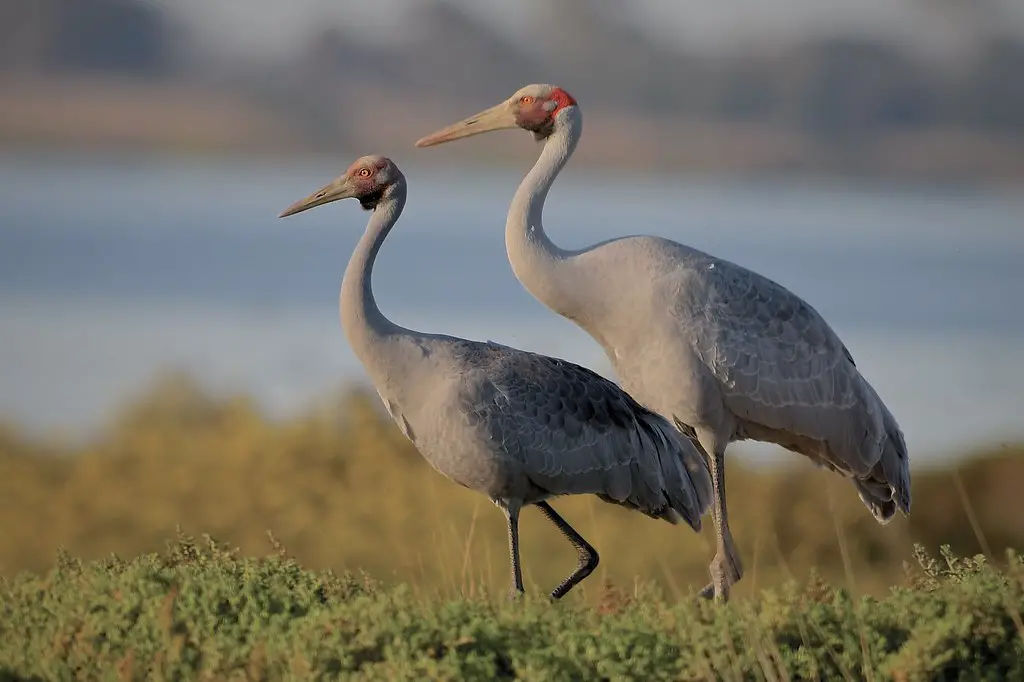
Image Source
- Scientific name: Grus rubicunda
- Lifespan: Up to 30 years
- Size: 100-120 centimeters (39-47 inches)
- Weight: 4-7 kilograms (8.8-15.4 pounds)
- Origin: Australia and New Guinea
Brolga is a large bird species found in Australia and New Guinea. It is known for its elegant and graceful appearance, with long legs, a slender neck, and a striking gray plumage. The Brolga is highly social and often forms large flocks, particularly during the breeding season when elaborate courtship displays are performed. It is known for its dancing rituals, where pairs of Brolgas leap and prance with outstretched wings, making trumpeting calls. The Brolga primarily feeds on plant matter, including grasses, seeds, and tubers, but it also consumes insects and small vertebrates. It is considered an important cultural symbol in Indigenous Australian traditions.
Black-crowned Night Heron
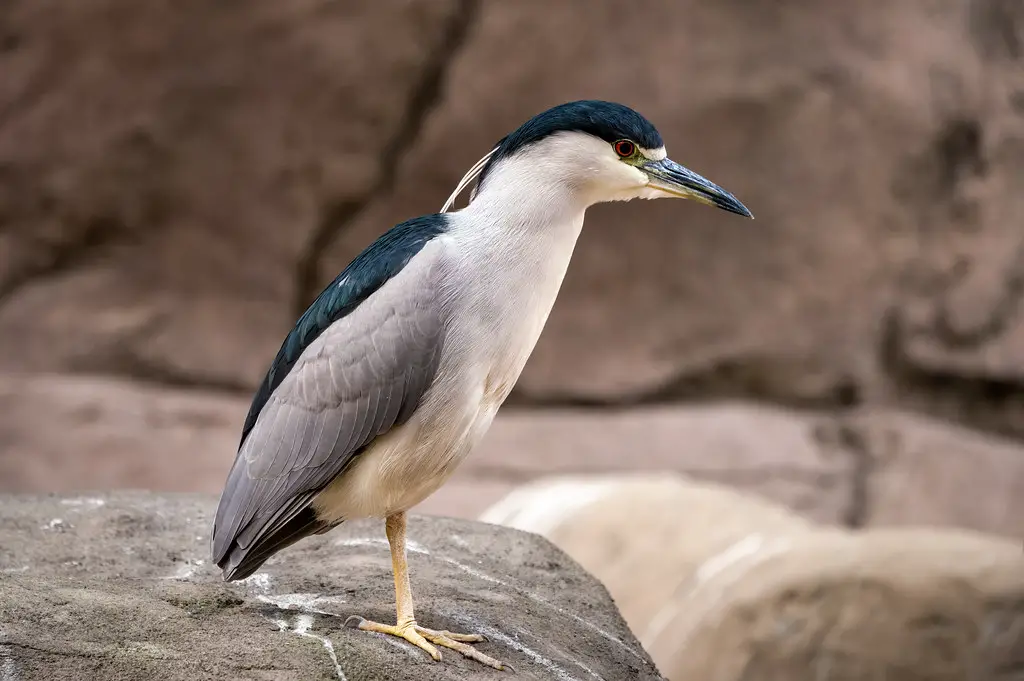
Image Source
- Scientific name: Nycticorax nycticorax
- Lifespan: Up to 20 years
- Size: 58-65 centimeters (23-26 inches)
- Weight: 550-800 grams (1.2-1.8 pounds)
- Origin: Worldwide distribution, found near bodies of water
Black-crowned Night Heron is a medium-sized heron species found in various parts of the world, including North and South America, Europe, Africa, and Asia. It has a distinctive black crown and back, contrasting with its gray underparts. As its name suggests, this heron is primarily active during the night and twilight hours, foraging for fish, amphibians, crustaceans, and other small prey in wetland habitats. During the day, it can often be seen perched on branches or in trees near water bodies. The Black-crowned Night Heron nests in colonies and builds stick nests in trees or shrubs, often in close proximity to other waterbirds.
Yellow-crowned Night Heron
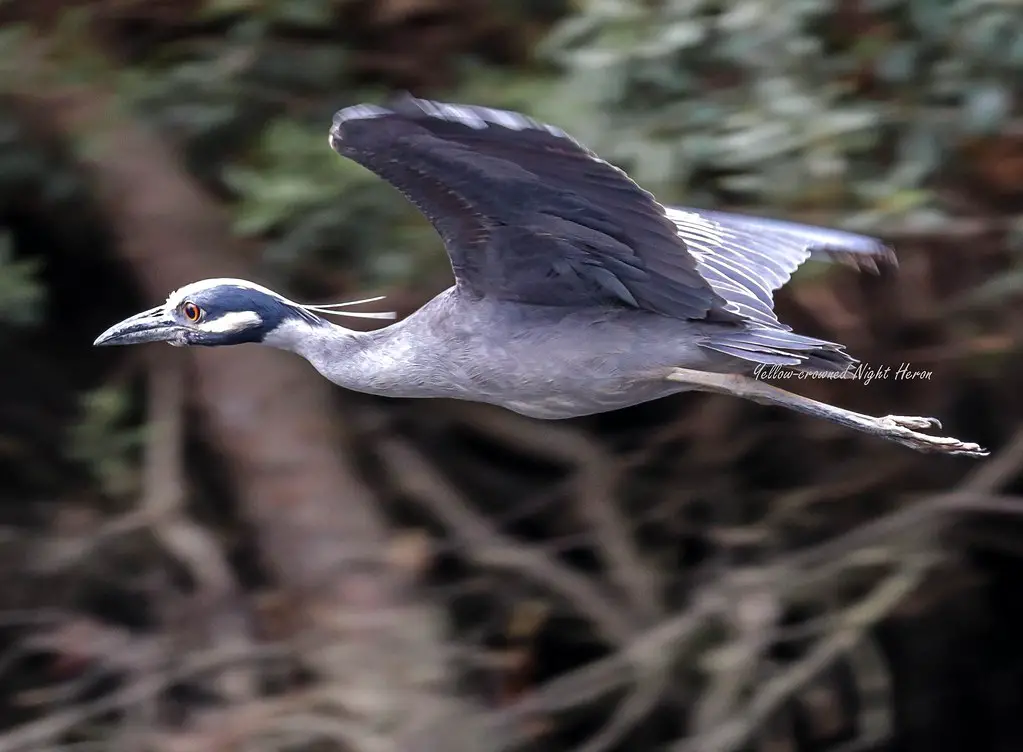
Image Source
- Scientific name: Nyctanassa violacea
- Lifespan: Up to 23 years
- Size: 58-66 centimeters (23-26 inches)
- Weight: 650-800 grams (1.4-1.8 pounds)
- Origin: Americas, from the southern United States to northern Argentina
Yellow-crowned Night Heron is a medium-sized heron species found in the Americas. It has a distinct appearance with a black crown, white underparts, and a yellowish or orange crown patch that extends down its nape. This heron is primarily a nocturnal feeder, using its sharp bill to capture a variety of prey including fish, amphibians, reptiles, crustaceans, and insects. During the day, it can be found resting or perched in trees near water sources. The Yellow-crowned Night Heron nests in trees or shrubs, often in colonies alongside other heron species. It is known for its deep, croaking calls and its secretive nature.
Intermediate Egret
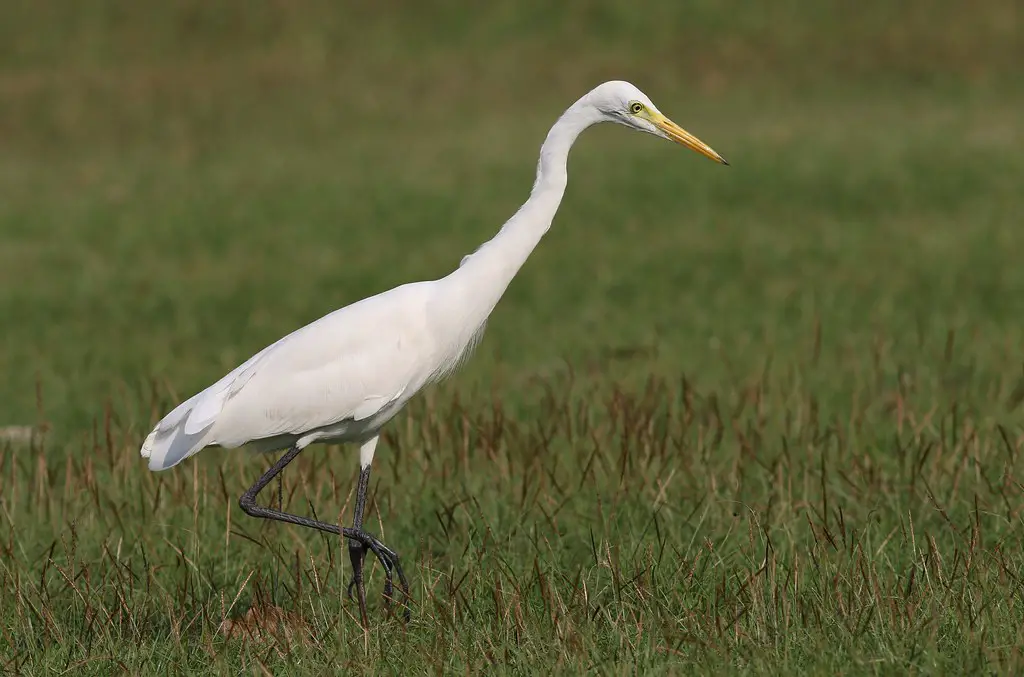
Image Source
- Scientific name: Ardea intermedia
- Lifespan: Up to 15 years
- Size: 56-76 centimeters (22-30 inches)
- Weight: 350-550 grams (0.8-1.2 pounds)
- Origin: Africa, Asia, and Oceania
Intermediate Egret, also known as the Median Egret, is a medium-sized heron species found in parts of Asia, Australia, and the Pacific region. It has a slender body, a long neck, and bright white plumage. Although it resembles the larger Great Egret, the Intermediate Egret is slightly smaller in size. It feeds on a variety of prey, including fish, frogs, crustaceans, and insects, and can be found in a range of wetland habitats such as marshes, swamps, and rice fields. During the breeding season, it develops long, filamentous plumes on its back and neck, which are used in courtship displays. The Intermediate Egret is often seen foraging alone or in small groups.
Western Reef Heron (Birds with Long Necks)
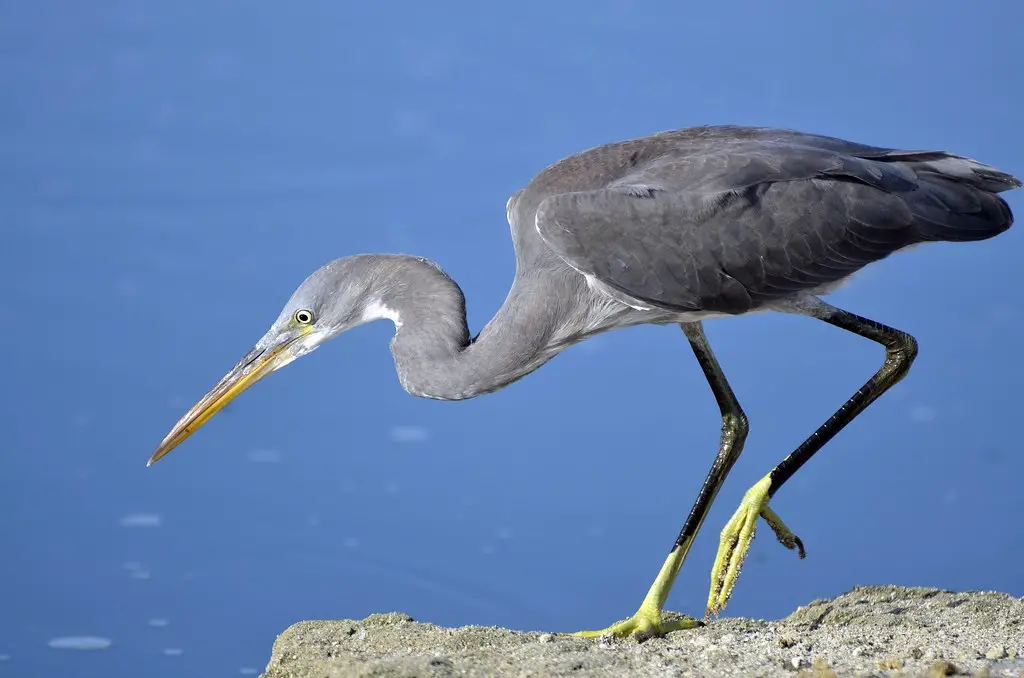
Image Source
- Scientific name: Egretta gularis
- Lifespan: Up to 15 years
- Size: 56-66 centimeters (22-26 inches)
- Weight: 400-600 grams (0.9-1.3 pounds)
- Origin: Coastal regions of Africa, Europe, and Asia
Western Reef Heron, also known as the Western Reef Egret, is a medium-sized heron species found in coastal areas of Africa, Europe, and Asia. It exhibits two color morphs: a dark morph with slate-gray plumage and a white morph with pure white plumage. It feeds mainly on fish, crustaceans, and other small marine creatures, which it catches by wading in shallow water or perching on rocks and tidal flats. The Western Reef Heron is an adaptable species that can be found in various coastal habitats, including mangroves, estuaries, and sandy beaches. It is known for its elegant flight and can often be seen soaring or gliding along the coastline.
White-faced Heron
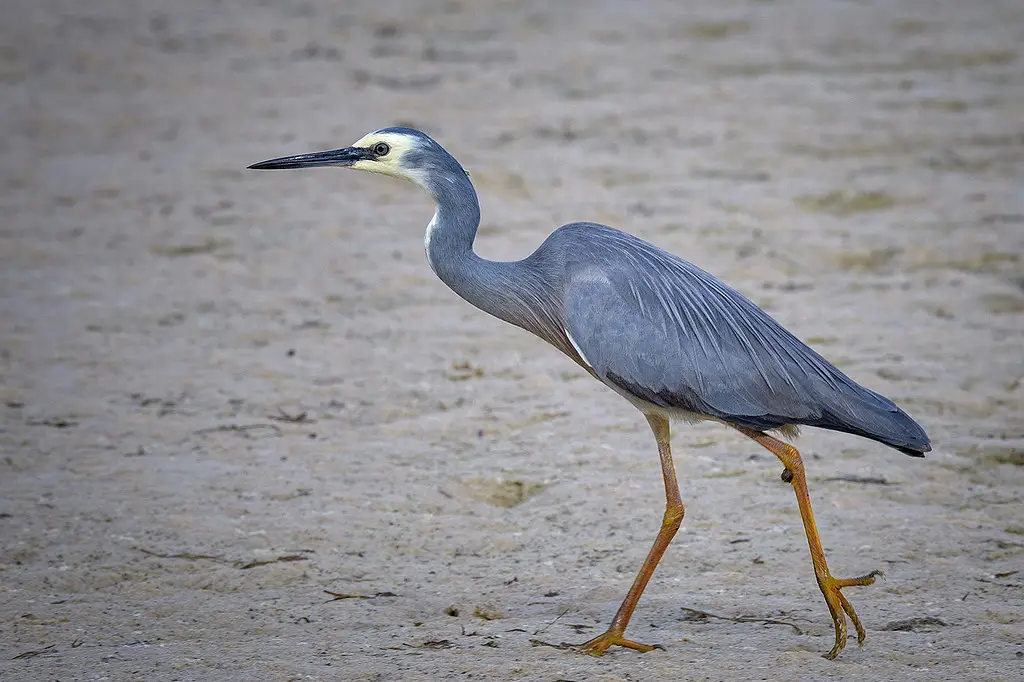
Image Source
- Scientific name: Egretta novaehollandiae
- Lifespan: Up to 20 years
- Size: 58-67 centimeters (23-26 inches)
- Weight: 600-1,000 grams (1.3-2.2 pounds)
- Origin: Australia, New Zealand, and nearby islands
White-faced Heron is a wading bird known for its elegant appearance. It has a slender body and long legs, allowing it to navigate wetland habitats with ease. Its name comes from the distinct white face that contrasts with its blue-gray plumage. This heron is skilled at patiently stalking its prey, including fish, frogs, and small invertebrates, before striking with its sharp beak.
Black Stork

Image Source
- Scientific name: Ciconia nigra
- Lifespan: Up to 30 years
- Size: 95-100 centimeters (37-39 inches)
- Weight: 3-4.5 kilograms (6.6-9.9 pounds)
- Origin: Europe, Asia, and parts of Africa
Black Stork is a large, striking bird with a distinctive appearance. It has a black plumage with a glossy sheen, and its long, red bill provides a beautiful contrast. This stork is known for its soaring flight and can often be found near rivers and wetlands, where it feeds on fish, amphibians, and small mammals. Its impressive size and unique coloration make it a captivating sight in the natural world.
Black-necked Stork (Birds with Long Necks)
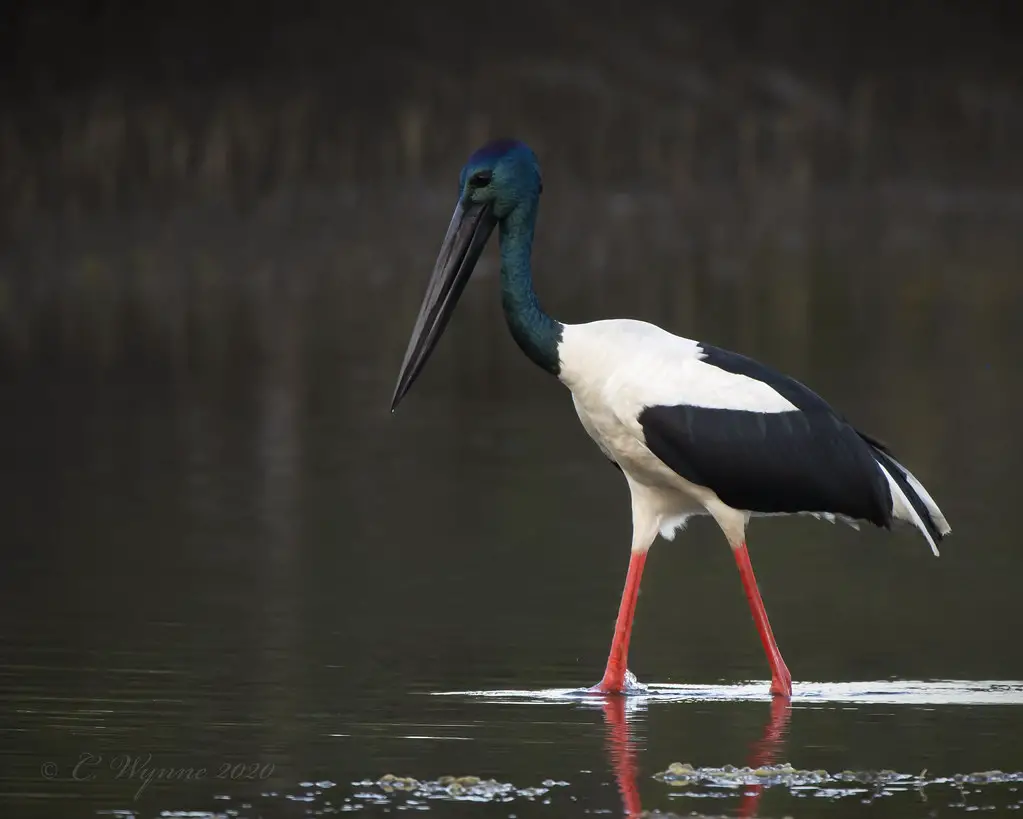
Image Source
- Scientific name: Ephippiorhynchus asiaticus
- Lifespan: Up to 20 years
- Size: 129-150 centimeters (51-59 inches)
- Weight: 4-7 kilograms (8.8-15.4 pounds)
- Origin: South and Southeast Asia, Australia
Black-necked Stork is a large and distinctive bird with black and white plumage. It has a long, thick black neck, which gives it its name, and a heavy bill that is red with a yellow tip. This stork is known for its graceful and slow flight as it forages for fish, frogs, and other small aquatic creatures in wetlands and shallow water bodies.
Sarus Crane

Image Source
- Scientific name: Antigone antigone
- Lifespan: Up to 40 years
- Size: 152-176 centimeters (60-69 inches)
- Weight: 6-12 kilograms (13-26 pounds)
- Origin: South Asia and Southeast Asia
Sarus Crane is the tallest flying bird and has a unique appearance. It has a gray body with a bright red head and upper neck, making it easily recognizable. This crane is found in wetlands and grasslands, where it feeds on insects, small vertebrates, and plant matter. Its distinctive trumpeting call is often heard during courtship displays.
Wattled Crane
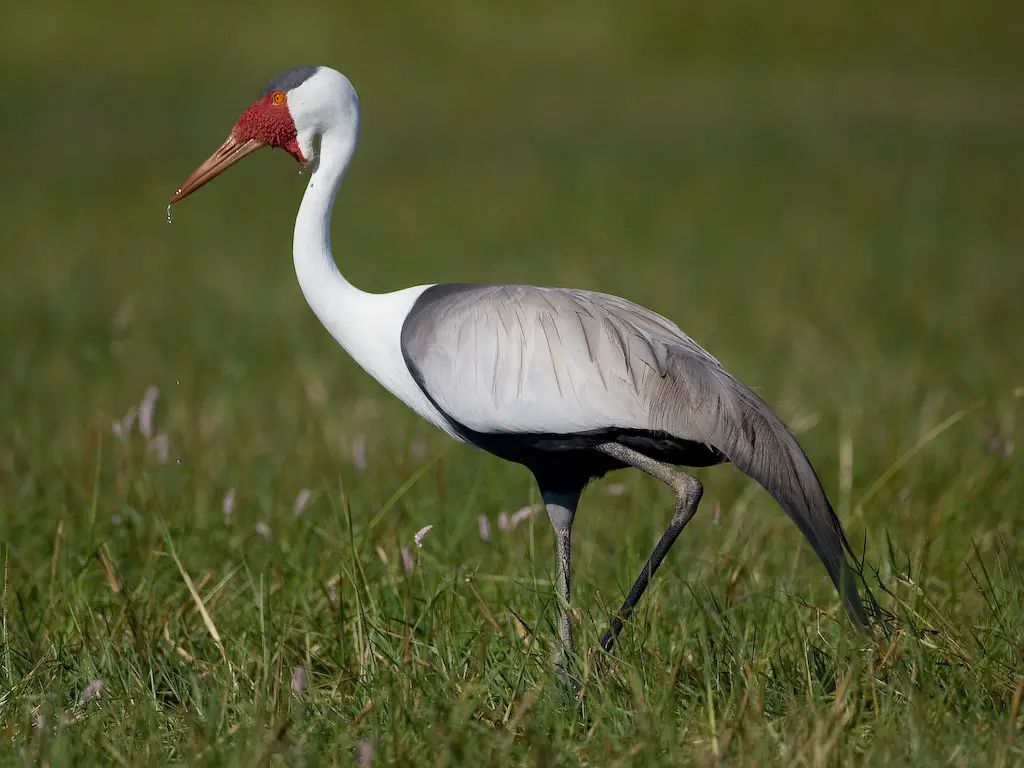
Image Source
- Scientific name: Bugeranus carunculatus
- Lifespan: Up to 25 years
- Size: 150-180 centimeters (59-71 inches)
- Weight: 5-7.7 kilograms (11-17 pounds)
- Origin: Sub-Saharan Africa
Wattled Crane is a large and striking bird known for its unique wattles, which are fleshy, dangling structures that hang from the sides of its head. It has a gray body, black and white wings, and a red crown. This crane is found in wetlands and marshy areas, where it feeds on a variety of plant matter, insects, and small aquatic animals. It is an endangered species, making its conservation a priority.
Final Thoughts on Birds with Long Necks
The world of birds with long necks has unveiled a mesmerizing realm of elegance and adaptability. These avian wonders have captivated us with their graceful stature and remarkable necks that defy expectations. From the serene swans to the patient herons, these birds showcase the marvels of evolution and the diversity of the natural world. The long necks of these avian marvels provide them with unique advantages, enabling them to navigate their environments, reach for food, and engage in elaborate courtship displays. As we conclude our journey, let us carry with us a renewed appreciation for the intricate beauty and remarkable adaptations of birds with long necks. May their graceful presence serve as a reminder of the boundless wonders that nature has to offer.
- Great Egret
- Great Blue Heron
- Snowy Egret
- Tricolored Heron
- Whooping Crane
- White-faced Ibis
- Limpkin
- American Flamingo
- Scarlet Ibis
- Gray Heron
- Purple Heron
- Red Egret
- Sandhill Crane
- Little Blue Heron
- Jabiru
- Cattle Egret
- Black-headed Heron
- Roseate Spoonbill
- Stork
- American Bittern
- Purple Gallinule
- Green Heron
- Brolga
- Black-crowned Night Heron
- Yellow-crowned Night Heron
- Intermediate Egret
- Western Reef Heron
- White-faced Heron
- Black Stork
- Black-necked Stork
- Sarus Crane
- Wattled Crane
- Great Egret
- Great Blue Heron
- Snowy Egret


![Birds with Beautiful Mohawks [Different Colors]](https://birdsology.com/wp-content/uploads/2024/02/INDIGO-Purple-crested-Turaco.jpg)
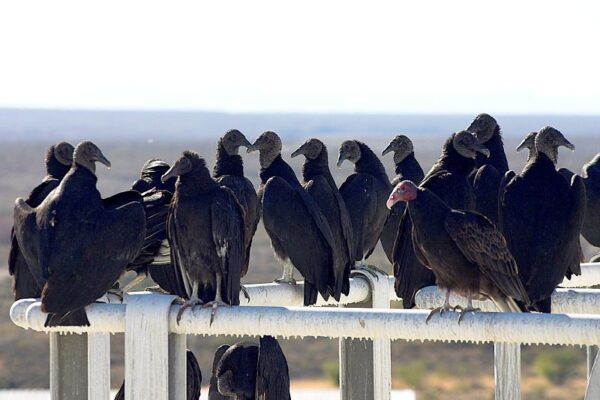
![Do Ducks Mate For Life? [A Comprehensive Guide]](https://birdsology.com/wp-content/uploads/2023/09/51650052390_19740dca95_b-600x400.jpg)

Private proxies and most useful rates: 50 discount, free proxies and special deals – only on DreamProxies.com